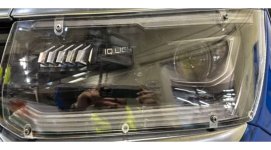Pretty silly regulation in the guise of road safety,
It only sounds silly if you don't understand optics and how light transmittance works with certain plastic materials in both new and aged conditions.
Headlamps are safety equipment. They are regulated devices that must meet specific electrical, mechanical, photometric, durability, and environmental requirements. These lamps are self-certified by the manufacturer to comply with applicable regulations.
When you place anything over the headlamp lens that impedes light transmission, you reduce the light output. As a result, the headlamp, which has already been
photometrically tested to be in compliance, may no longer meet the required light intensity at specific angles. The ultimate goal is to prevent a significant reduction in light output that would render the beam pattern non-compliant. In other words, the minimum light levels at certain angles must still be achieved, and the maximum allowable output at other angles must not be exceeded. This can only be done in a certified lighting laboratory.
Clear plastic covers can compromise the lamp's safety performance. Even when brand new, these covers can block a significant amount of light. Over time, as the cover ages and deteriorates, it can also cause beam distortion, leading to increased glare and backscatter. Additionally these covers may lack the specialized surface treatments and protective coatings against UV exposure and abrasion that headlamp lenses require.
OEM headlamps must comply with the physical testing procedures outlined in FMVSS 108, including the Abrasion Test (S14.6.1), Chemical Resistance Test (S14.6.2), and the Plastic Optical Material Test (S14.4.2). There is a registry for optical-grade plastics and hard coatings known as the
AMECA List of Acceptable Plastics, which OEMs adhere to.
Despite following these regulatory protocols, it is apparent that many factory hard coatings on today’s headlamps are not as durable as they arguably should be. Now, imagine how untreated and untested clear plastic covers would hold up under the same conditions. This is why clear covers are prohibited by law.

